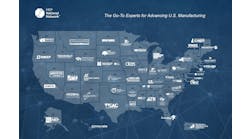A demand spike during the pandemic prompted manufacturers to buy sketchy components, putting themselves at legal risk.
Over the last hundred years, asbestos, a toxic insulation substance, has been so widely used that the legal risks of asbestos in the supply chain are substantial. The COVID-19 pandemic and the lingering supply chain disruption it spawned multiplied that risk.
A demand spike prompted much of this disruption. When global lockdowns ended, downsized businesses could not keep up with the dramatic economic recovery. Manufacturing, the last remaining active asbestos-use area, was one of the hardest-hit sectors. So, manufacturers scoured the globe in order to meet increased demand for their goods. As a result, they often bought parts from countries that, for political or other reasons, did not have accurate labels.
Other businesses took shortcuts. Talc-asbestos cross-contamination is a good example. Talc is a common ingredient in not only talcum powder, such as baby powder, but also in a wide range of other consumer products, mostly cosmetics and food-like products, such as chewing gum and prescription drugs. In the scramble to put products on the shelves, companies relaxed quality assurance/quality control (QA/QC) measures, which allowed asbestos-laced talc into consumer products.
As a result, businesses that previously cared little about asbestos legal liability should now pay close attention to this area. In many states, even if providers do not have actual knowledge of asbestos contamination, an asbestos exposure lawyer can still obtain substantial damages for exposure victims.
Asbestos Use in the United States
Many people assume that since asbestos is now a banned substance in the United States, and its use has dropped significantly since 1980, that most other countries have also banned asbestos—or at least no longer use this toxic substance. As outlined below, that’s simply not the case.
Furthermore, the domestic asbestos ban is having diminished impact, mostly because it does not include a product recall. So, the thousands of asbestos-laden foreign manufactured products that have come into the country recently, such as Chinese auto parts, are still in use. Additionally, the EPA ban only affects one kind of asbestos. Foreign manufacturers and other asbestos users could easily pivot to a similar kind to get around restrictions.
Moreover, the EPA ban does not include critical QA/QC oversight measures. So, as outlined above, asbestos-laced products are still in the supply chain. We mentioned asbestos-laced talc above. Asbestos-laced vermiculite, an asbestos insulation substitute, is another example. For decades, the W.R. Grace Company shipped asbestos-laced vermiculite all over America. The problem persists to this day because asbestos-contaminated vermiculite was used so extensively, the cleanup process is expensive and slow, and regulations allow legacy materials to remain in place.
Worldwide Asbestos Usage
Continued widespread asbestos use, e-commerce purchases and lax testing procedures allow dangerous substances like asbestos into domestic products.
Many countries, such as China and Russia, place almost no restrictions on asbestos mining and usage. The regulatory environments in these countries may tighten up soon, but that change is several years away, at best.
E-commerce is a time-saving measure for many companies that desperately need certain components. But e-commerce purchases are also sight-unseen purchases. Many companies only have a general idea as to what a foreign manufacturer might provide. There’s certainly no opportunity to test for asbestos or another substance before the part enters the stream of commerce.
These products then pass into the hands of unsuspecting consumers. When their asbestos-related injury claims go to court—and they eventually will go to court—finger-pointing usually isn’t a legal defense. Companies must take action now to avoid liability judgments later.
Failure to test parts and products that often contain this substance is a major problem. Asbestos-talc cross-contamination is an even bigger problem.
Chemically, asbestos and talc are almost exactly the same substance. As a result, asbestos and talc mines usually overlap, making cross-contamination at the source almost inevitable. Such cross-contamination is not a problem, as long as the company employs firm QA/QC procedures later in the process.
Once again, the issue is worldwide. A recent study indicated that asbestos-laced talc from other countries, such as India, might outstrip the asbestos-laced talc in Johnson & Johnson’s talcum powder.
Avoiding the Legal Risks of Asbestos in the Supply Chain
Latency, legacy and lethargy are the three primary reasons asbestos-laced products are in today’s supply chain.
Many asbestos-exposure illnesses, such as mesothelioma cancer, have more than a 70-year latency period. Therefore, today’s executives may know nothing about the problem—and often feel little motivation to cure problems that won’t surface for decades, if at all.
Mesothelioma, especially second-hand mesothelioma, is a very nasty form of a very nasty disease. People who handle asbestos, such as in manufacturing or construction, are at least somewhat aware of the risk. Take-home asbestos poisoning victims usually know nothing about it. When the family washed and spent time around their spouse or parent home from a manufacturing job, family members had no idea they were inhaling asbestos fibers that clung to the fabric.
Legacy is important because many companies take a “that’s the way we’ve always done it” approach to production methods. If these methods don’t include stringent asbestos control measures—and they probably don’t—they are reluctant to adopt them. These companies eventually pay the price via lawsuits.
Simple lethargy may be the biggest contributing factor to asbestos exposure illnesses. I generally recommend that all companies that use any foreign-manufactured parts, or talc, work with an industrial hygienist and immediately implement any recommendations.





